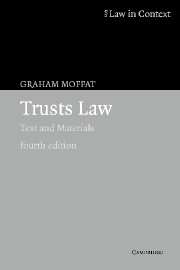Book contents
- Frontmatter
- Contents
- Preface
- Acknowledgments
- Table of abbreviations
- Useful websites
- Table of statutes
- Table of statutory instruments
- Table of cases
- 1 Trusts introduced
- 2 The evolution of the private express trust
- 3 Taxation, wealth-holding and the private trust
- 4 Creating the Trust – I
- 5 Creating the Trust – II
- 6 Trusts and public policy
- 7 Flexibility in relation to beneficial entitlement
- 8 The taxation of private trusts
- 9 An introduction to trustees and trusteeship
- 10 Aspects of the management of trusts
- 11 Trusteeship, control and breach of trust
- 12 Imputed trusts and family breakdown
- 13 Trusts in commerce I: occupational pension schemes
- 14 Trusts in commerce II: commerce and equitable remedies
- 15 Trusts in commerce III: commerce, credit and the trust
- 16 Trusts in commerce IV: fiduciary relationships, commerce and the trust
- 17 Trust, contract and unincorporated associations
- 18 An introduction to the law of charity
- 19 A legal definition of ‘charity’
- 20 The regulation of charities
- Index
Preface
- Frontmatter
- Contents
- Preface
- Acknowledgments
- Table of abbreviations
- Useful websites
- Table of statutes
- Table of statutory instruments
- Table of cases
- 1 Trusts introduced
- 2 The evolution of the private express trust
- 3 Taxation, wealth-holding and the private trust
- 4 Creating the Trust – I
- 5 Creating the Trust – II
- 6 Trusts and public policy
- 7 Flexibility in relation to beneficial entitlement
- 8 The taxation of private trusts
- 9 An introduction to trustees and trusteeship
- 10 Aspects of the management of trusts
- 11 Trusteeship, control and breach of trust
- 12 Imputed trusts and family breakdown
- 13 Trusts in commerce I: occupational pension schemes
- 14 Trusts in commerce II: commerce and equitable remedies
- 15 Trusts in commerce III: commerce, credit and the trust
- 16 Trusts in commerce IV: fiduciary relationships, commerce and the trust
- 17 Trust, contract and unincorporated associations
- 18 An introduction to the law of charity
- 19 A legal definition of ‘charity’
- 20 The regulation of charities
- Index
Summary
This book seeks to present the law of trusts in a different way from conventional texts. The underlying premise is that an investigation of the social and legal contexts in which trusts commonly appear, and of the functions which trusts perform within these contexts, is an essential prerequisite to a proper understanding of trusts law. Developments that have occurred in the relevant social and legal contexts since the first edition of this book have confirmed our conviction in the value of this approach. The bulk of the book is therefore again divided into four parts: trusts and the preservation of family wealth (Chapters 3–11); trusts and family breakdown (Chapter 12); trusts and commerce (Chapters 13–16); and trusts and non-profit activity (Chapters 17–20). The gathering pace of legal change has, however, impelled us to make extensive revisions and additions to the text. Prominent amongst the many statutory changes are the Trustee Act 2000 and the Pensions Act 2004 whilst key aspects of the Charities Bill 2004 have also been incorporated where possible. Important cases such as BCCI v Akindele, Foskett v McKeown, Schmidt v Rosewood and Twinsectra v Yardley, together with an outpouring of academic literature, have all in their different ways contributed to a continuing debate about trusts law, particularly in its relationship to other areas of the common law. The effect of these influences is evident in all four parts of the book.
- Type
- Chapter
- Information
- Trusts LawText and Materials, pp. xviii - xxPublisher: Cambridge University PressPrint publication year: 2005

